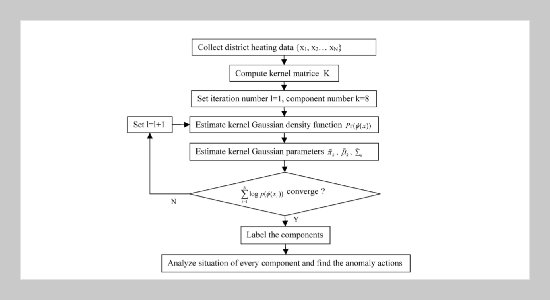REFERENCES
- [1] http://news.ces.cn/gongre/gongreshichang/2015/10/ 13/77971_1.shtml.
- [2] http://www.china-heating.com/news/2016/30125. html.
- [3] Baldvinsson, I. and Nakata, T., “AFeasibility and Performance Assessment of a Low Temperature District Heating System–a North Japanese Case Study,” Energy, Vol. 95, pp. 155�174 (2016). doi: 10.1016/j. energy.2015.11.057
- [4] Wang, P. and Sipilä, K., “Energy-consumption and Economic Analysis of Group and Building Substation Systems—a Case Study of the Reformation of the District Heating System in China,” Renewable Energy, Vol. 87, pp. 1139�1147 (2016). doi: 10.1016/j.renene. 2015.08.070
- [5] Zaunbrecher, B. S., Arning, K., Falke, T., et al., “No Pipes in My Backyard: Preferences for Local District Heating Network Design in Germany,” Energy Research & Social Science, Vol. 14, pp. 90�101 (2016). doi: 10.1016/j.erss.2016.01.008
- [6] Shamshirband, S., Petkovic, D., Enayatifar, R., et al., “Heat Load Prediction in District Heating Systems with Adaptive Neuron-fuzzy Method,” Renewable and Sustainable Energy Reviews, Vol. 48, pp. 760�767 (2015). doi: 10.1016/j.rser.2015.04.020
- [7] Yeh, H. M., “Heat Transfer Performance in Doublepass Flat-plate Heat Exchangers with External Recycle,”Journal of Applied Science and Engineering, Vol. 17, No. 3, pp. 293�304 (2014). doi: 10.6180/jase. 2014.17.3.10
- [8] Lee, C. Y., Huang, H. H., Lee, S. M., et al., “Numerical Simulation of the Heat Transfer Characteristics of Low-Watt Thermosyphon Influence Factors,” Journal of Applied Science and Engineering, Vol. 17, No. 4, pp. 423�428 (2014). doi: 10.6180/jase.2014.17.4.09
- [9] Haves, P., “Overview of Diagnostic Methods,” Proceedings of the Workshop on Diagnostics for Commercial Buildings: From Research to Practice, pp. 16– 17 (1999).
- [10] Ahonen, M., Hyvärinen, J., Kuismin, J. and Pakanen, J., Fault Detection Methods for District Heating Substations, Research notes 1780. Oulu: VTT Building Technology (1996).
- [11] Sandin, F., Gustafsson, J. and Delsing, J., Fault Detection with Hourly District Energy Data, Stockholm: Swedish District Heating Association (2013).
- [12] Kiluk, S., “Algorithmic Acquisition of Diagnostic Patterns in DistrictHeating BillingSystem,”Appl Energy, Vol. 91, pp. 146–155 (2012). doi: 10.1016/j.apenergy. 2011.09.023
- [13] Delsing, J. and Svensson, B., “En ny method för funktionsdiagnos och felsökning av fjärrvärmecentraler utifrån värmemängdsdata (a new method for operation diagnosis and fault detection in substations by using heat meter readings),” Luleå: EISLAB, Luleå University of Technology (2001).
- [14] Sandin, F., Gustafsson, J., Eklund, R. and Delsing, J., “Basic Methods for Automated Fault Detection and Energy Data Validation in Existing District Heating Systems,” 13th International Symposium on District Heating and Cooling, Copenhagen (2013).
- [15] Gadda, H. and Werner, S., “Fault Detection in District Heating Substations,” Applied Energy, Vol. 157, pp. 51�59 (2015). doi: 10.1016/j.apenergy.2015.07.061
- [16] Isermann, R., Fault-diagnosis Applications, Springer, Berlin Heidelberg, p. 354 (2011).
- [17] Isermann, R., Fault-Diagnosis Systems–an Introduction from Fault Detection to Fault Tolerance, Springer, Berlin Heidelberg, p. 475 (2006).
- [18] Yamanishi, K. and Takeuchi, J., “Discovering Outlier FilteringRulesfromUnlabeled Data:CombiningaSupervised Learner with an Unsupervised Learner,” Proceedings of the Seventh ACM SIGKDD International Conference on Knowledge Discovery and Data Mining, ACM, pp. 389�394 (2001).
- [19] Ramaswamy, S., Rastogi, R. and Shim, K., “Efficient Algorithms for Mining Outliers from Large Data Sets,” ACM SIGMOD Record, ACM, Vol. 29, No. 2, pp. 427�438 (2000).
- [20] Arning, A., Agrawal, R. and Raghavan, P., “A Linear Method for Deviation Detection in Large Databases,” Proceedings of the 2nd International Conference on Knowledge Discovery and Data Mining (KDD-96), pp. 164�169 (1996).
- [21] Ester, M., Kriegel, H. P., Sander, J., et al., “ADensitybased Algorithm for Discovering Clusters in Large Spatial Databases with Noise,” Proceedings of the 2nd International Conference on Knowledge Discovery and Data Mining (KDD-96), Vol. 96, No. 34, pp. 226�231 (1996).
- [22] Li, R., Wang, Z., Gu, C., et al., “A Novel Time-of-use Tariff Design Based on Gaussian Mixture Model,” Applied Energy, Vol. 162, pp. 1530�1536 (2016).
- [23] Jeong, Y. S. and Jayaraman,R., “Support Vector-based Algorithms with Weighted Dynamic Time Warping Kernel Function for Time Series Classification,” Knowledge-Based Systems, Vol. 75, pp. 184�191 (2015).
- [24] Zahra, S., Ghazanfar, M. A., Khalid, A., et al., “Novel Centroid Selection Approaches for KMeans-clustering Based Recommender Systems,” Information Sciences, Vol. 320, pp. 156�189 (2015).
- [25] Wang, J., Lee, J. and Zhang, C., “Kernel Trick Embedded Gaussian Mixture Model,” Lecture Notes in Computer Science, Vol. 2842, pp. 159–174 (2003).
- [26] Ji, C., Liu, S., Yang, C., et al., “IBDP: an Industrial Big Data Ingestion and Analysis Platform and Case Studies,” 2015 International Conference on Identification, Information, and Knowledge in the Internet of Things (IIKI), IEEE, pp. 223�228 (2015).
















